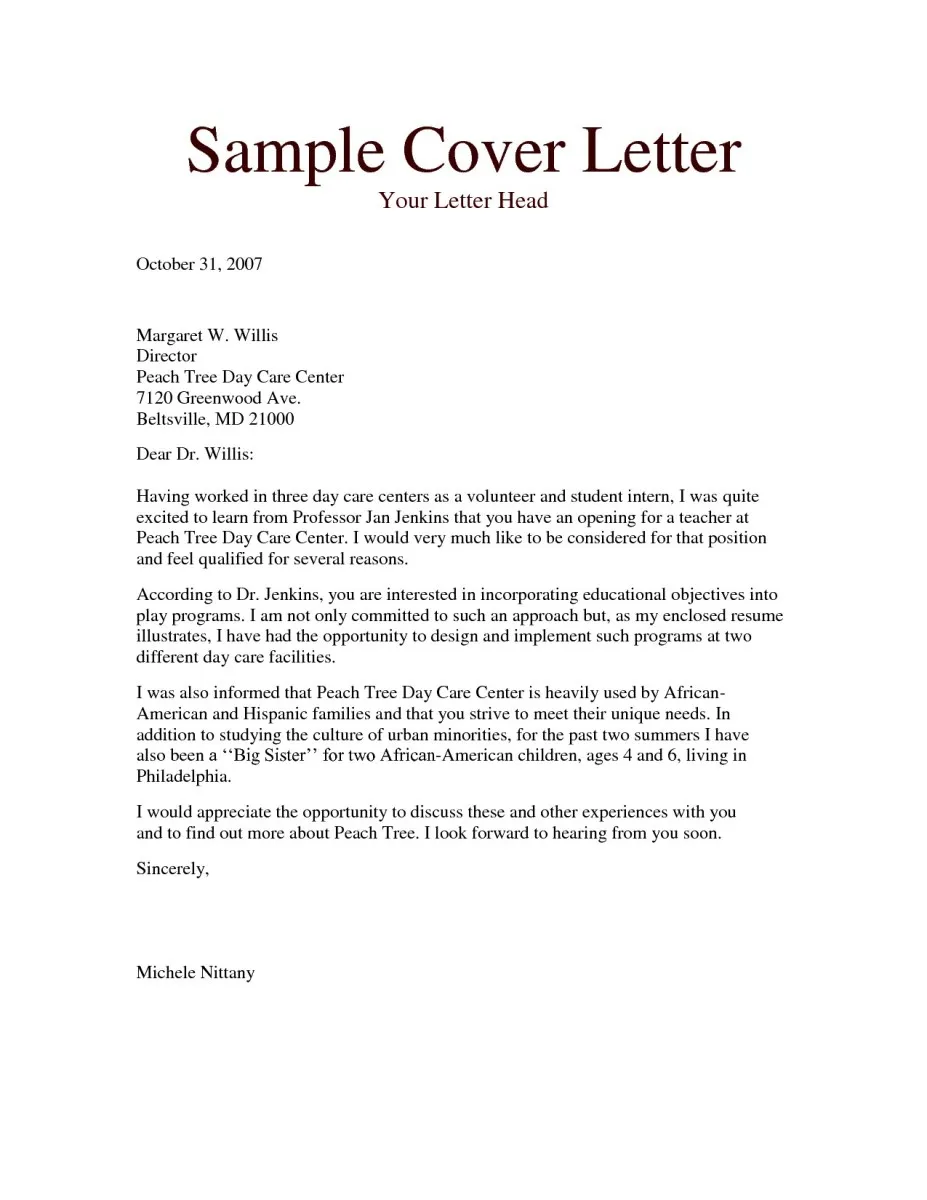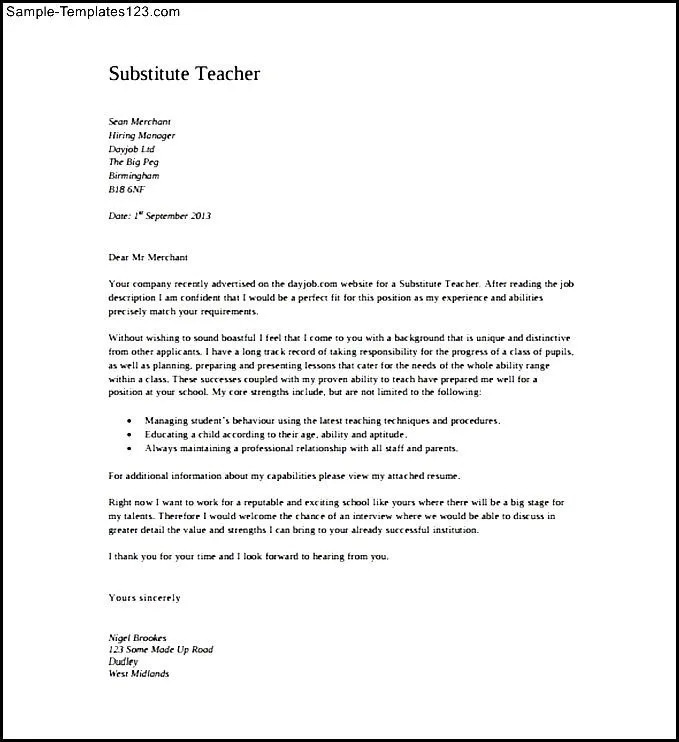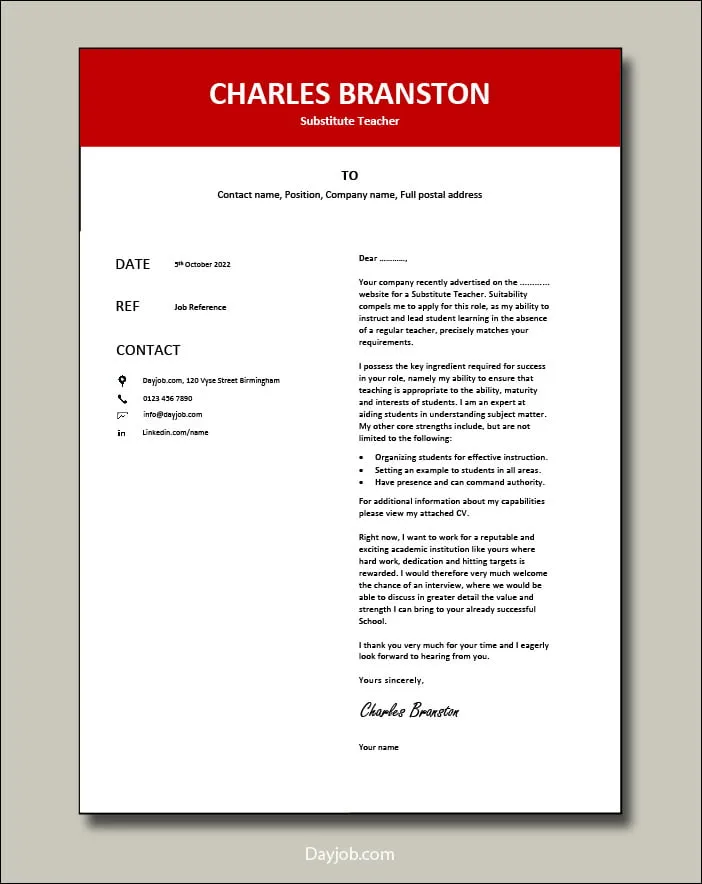Understanding the Substitute Teacher Cover Letter
A cover letter for a substitute teacher position is more than just a formality its your first chance to make a positive impression and demonstrate why you’re the ideal candidate. It serves as a brief introduction, a showcase of your skills, and an opportunity to express your enthusiasm for the role. Unlike a resume which primarily lists your qualifications, a cover letter provides context and allows you to highlight the specific skills and experiences most relevant to the job. A well-crafted cover letter can significantly increase your chances of securing an interview, and ultimately, landing the position. Many applicants overlook the importance of a strong cover letter, so taking the time to write a compelling one can set you apart from the competition.
Why a Cover Letter is Crucial for Substitute Teachers
In the competitive field of education, especially for substitute positions, a cover letter is essential. It allows you to personalize your application and tailor it to the specific school or district. This personalization demonstrates your genuine interest and attention to detail. Furthermore, a cover letter gives you the opportunity to explain any gaps in your employment history or address any concerns the hiring manager might have. It shows that you are proactive, professional, and have taken the time to thoughtfully consider how your skills align with the needs of the school. Without a cover letter, your application may seem generic, and you risk missing out on the chance to highlight what makes you unique.
Highlighting Your Qualifications

When crafting your cover letter, focus on the qualifications that make you a suitable candidate. Start by clearly stating your teaching credentials and any relevant certifications, such as a teaching license or a substitute teaching permit. Detail your educational background, including degrees earned and any specializations. It’s also vital to mention any professional development courses or workshops you’ve completed, especially those related to classroom management, curriculum development, or working with diverse student populations. If you have experience with specific age groups or subject areas, be sure to highlight those as well. This targeted approach ensures the hiring manager immediately sees your suitability for the role, increasing your chances of selection.
Showcasing Relevant Experience
Your previous experience is a key selling point in your cover letter. Provide specific examples of your work in educational settings. This could include experience as a teacher, teaching assistant, tutor, or volunteer in a school environment. For each experience, describe your responsibilities and accomplishments. Quantify your achievements whenever possible. Instead of saying you “helped students,” specify how you “increased student test scores by 15%” or “assisted in managing a classroom of 25 students.” Mention any special projects you led or any awards you received. This will help the hiring manager visualize your skills and understand the value you would bring to their school. Make sure to tailor your experiences to the specific needs of the school or district.
Emphasizing Adaptability and Flexibility
Substitute teachers must be adaptable and flexible to succeed. Highlight your ability to quickly learn new classroom routines, adapt to different teaching styles, and manage unexpected situations. Provide examples of times when you successfully adjusted to changes in plans or handled challenging classroom dynamics. These qualities are highly valued in substitute teachers, as they often step into unfamiliar environments with little preparation. You might mention your willingness to teach a variety of subjects or your comfort level with different age groups. Showcase your ability to remain calm under pressure and handle unexpected events effectively. These skills are paramount for providing a smooth and positive learning experience for students in the absence of their regular teacher.
Demonstrating Classroom Management Skills

Strong classroom management is a must for substitute teachers. Describe your experience with different classroom management techniques, such as positive reinforcement, clear communication, and establishing routines. Give specific examples of how you’ve maintained a positive and productive learning environment. This could include how you handled disruptive behavior, implemented classroom rules, or kept students engaged in lessons. Mention any training you’ve had in behavior management, such as CPI or other relevant certifications. Showcasing your ability to create a safe and structured learning environment is critical, as this ensures that student learning continues seamlessly while the regular teacher is away. Schools often look for candidates who can maintain order and foster a positive learning atmosphere.
Mentioning Specific Skills
In your cover letter, be sure to list skills relevant to teaching, such as lesson planning, curriculum implementation, and assessment. If you’re proficient in any specific subjects or grade levels, mention those as well. Highlight any experience with educational technology, such as interactive whiteboards or learning management systems. Do not forget to mention any language skills or experience working with students with special needs. By highlighting these specific skills, you make it clear that you’re a well-rounded candidate capable of addressing a range of teaching challenges and environments. Tailor these skills to match the requirements of the specific substitute positions you are applying for.
Highlighting Your Educational Philosophy
Briefly express your educational philosophy. This could be your belief in student-centered learning, differentiated instruction, or creating a positive classroom environment. Your educational philosophy helps the hiring manager understand your teaching approach and values. Use this section to share how you make connections with students and foster a love of learning. This personal touch can leave a lasting impression. It demonstrates your passion for teaching. It gives the hiring manager insight into what motivates you to work with students. This helps them decide if your teaching style aligns with the school’s values. This will help you stand out as a candidate.
Addressing Potential Concerns

Use the cover letter to address potential concerns about your application proactively. If you have gaps in your employment history, briefly explain them. Frame these situations positively by highlighting what you learned during the break. If you have any specific limitations or requirements, such as needing specific accommodations, be transparent. Addressing potential concerns shows that you are honest and proactive. This will help the hiring manager understand your situation and assess your suitability. Be direct, but avoid negativity. Focus on the positive aspects and what you have to offer. This proactive approach can prevent misunderstandings and keep your application in consideration.
Formatting Your Cover Letter
Proper formatting is critical for a cover letter. Use a professional font, such as Times New Roman or Arial, with a readable font size (11 or 12 points). Keep your cover letter concise, ideally no more than one page. Use clear, concise language, and avoid jargon or overly complex sentences. Use bullet points to highlight key skills and experiences. Make sure your cover letter is well-organized, with clear headings and paragraphs. Use consistent spacing throughout the document. Proofread carefully for any grammar, spelling, or punctuation errors. A clean, well-formatted cover letter shows attention to detail and professionalism.
Contact Information
Always include your complete contact information at the top of your cover letter. This should include your full name, phone number, and email address. It’s also a good idea to provide a link to your LinkedIn profile or a personal website, if you have one. Make sure your email address is professional. Ensure your voicemail message is also professional. This ensures that the hiring manager can easily reach you. Double-check all contact details to prevent any communication issues. This is especially important since substitute positions require quick communication.
Opening and Closing Statements

Your opening paragraph is your first chance to grab the reader’s attention. State the position you are applying for and where you saw the job posting. Briefly introduce yourself and your enthusiasm for the role. In the closing paragraph, reiterate your interest in the position and thank the hiring manager for their time and consideration. Express your willingness to interview and provide any additional information. End with a professional closing, such as “Sincerely” or “Respectfully.” Ensure your tone is enthusiastic but professional. These opening and closing statements set the tone for your application.
Proofreading and Editing
Proofreading and editing are essential steps. Before submitting your cover letter, carefully review it for any errors in grammar, spelling, and punctuation. It is also a good practice to read your cover letter out loud. Ensure that the text flows naturally and is easy to understand. Consider asking a friend, family member, or career counselor to review your cover letter. A fresh pair of eyes can often catch mistakes that you may have missed. Ensure that your cover letter is tailored to the specific school. A well-edited cover letter will increase your chances of getting selected for the interview.
The Power of a Compelling Cover Letter
A well-crafted cover letter can significantly improve your chances of landing a substitute teaching position. By highlighting your qualifications, showcasing your experience, and demonstrating your adaptability and flexibility, you can make a compelling case for why you are the perfect candidate. Remember to tailor your cover letter to each position, emphasizing the skills and experiences most relevant to the specific school or district. Through careful planning, formatting, and proofreading, your cover letter can open doors to exciting opportunities and a fulfilling career as a substitute teacher. It will help you stand out in a crowded field and demonstrate your professionalism and passion for teaching. Always remember that the cover letter is your voice. Make it count!
